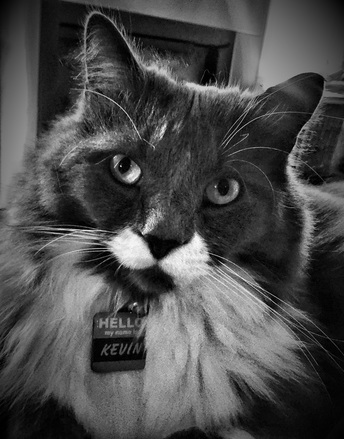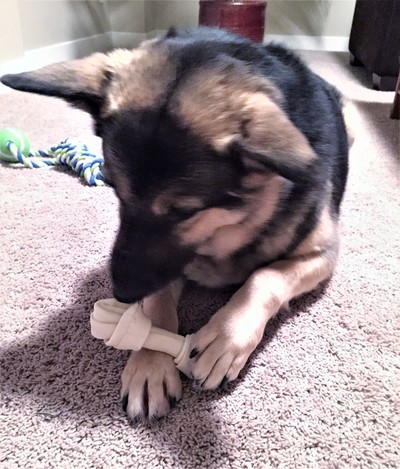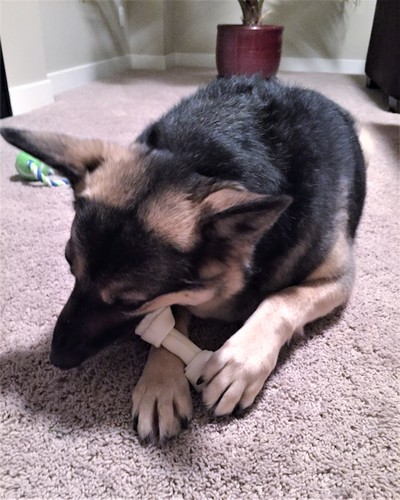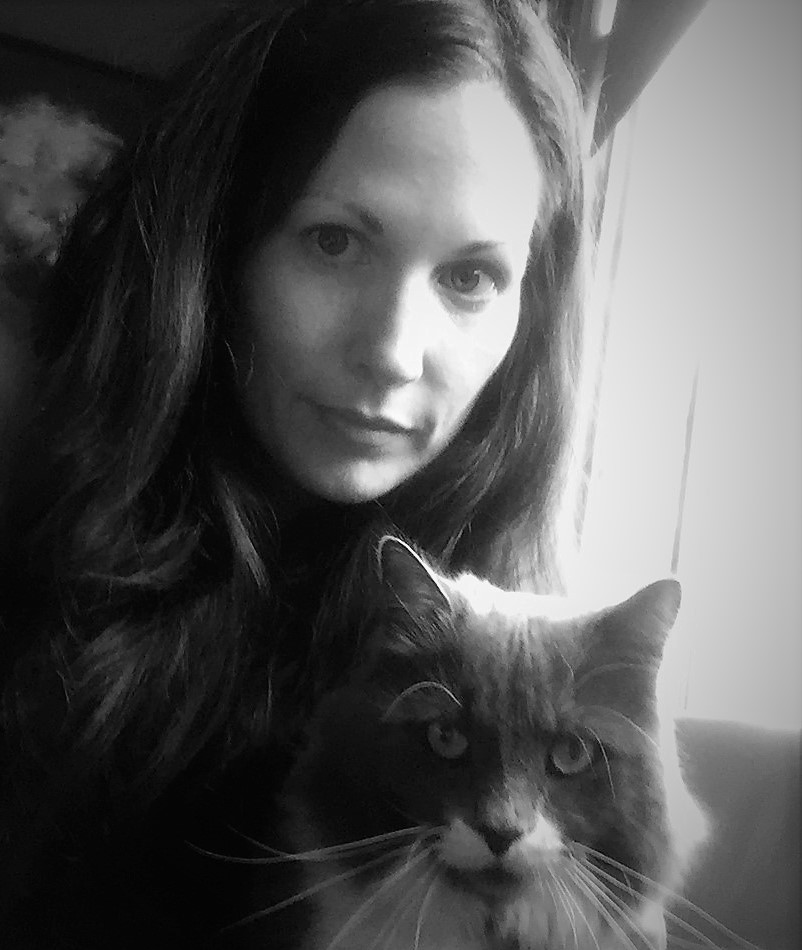|
"Throw them a bone" - Keeping upper management occupied and off -your -back. Mikey loves to eat his bone. He takes it to his favourite place on the living room floor and begins to gnaw. A distraction that has him snarfling in happiness for hours.
When projects appear to be planned effectively or there have been few complaints, upper management gets scared. Option 1 - because there is something wrong with the project process and no one is talking or Option 2 - they are bored and want to make sure it appears they are still in control. With Option 1, you have bigger issues and should re-evaluate your position or ask for help. Option 2 - it is time to find a small element of the project you can toss to the boss to chew-on while you keep the project moving forward. The bone (element/item/issue) you throw should not have a major impact to your overall deliverable or have negative consequences if the chewing gets out of your control. The bone is not to be taken away until it is finished or devoured. If the bone is taken away too early, then said management is left dissatisfied and looking for more. Do not take toys away until everyone is finished playing. Distractions in the workplace are good when regulated. Visual distractions - there is nothing wrong with eye-candy in the office male, female, or gender neutral. Verbal distractions - chatting about the weekend with your pod-mates. Food distractions - getting up from your desk to have a treat. Project distractions - discussing other project success and failures with the office. The infamous multi-tasking theory is also known as multi-distractions. There are some individuals who can do one or more tasks simultaneously. They live in the ocean and have 8 tentacles. Attention to a specific task or element can ensure success as it has your concentrated efforts. Leaving issues that have not been carefully evaluated creates more work to fix after the team realizes there are errors in the decision making. Knowing when and where to give your full attention is a separate topic, but reviewing items with complete attention by yourself or the team can get good results. Mikey finishes his bone, licks his chops, and settles for a nap. He is content until he needs another bone. Meanwhile, the work keeps getting done. Mikey can be found at - www.britannicafitness.com
1 Comment
There are worse and better decisions - but one has to be made to keep a project going forward. Kevin sits at an open door and stares out at the backyard. The temperature has dropped to bloody cold and he is unsure if his paws deserve the uncomfortable chill in lieu of exploring inside the confines of his fence.
Finally, he turns around and walks back inside to his chair. He made his decision. His time on the fence will have to wait until a warmer day. Did he make the right decision? That depends on what his objective was. If his goal was to see if the Black Squirrel of Evil was unexpectedly flattened in the alley, then no, he did not succeed. If he wanted to take a temperature reading, then his efforts were successful. In either scenario, Kevin acted upon an action - a decision. A simple decision can move a project forward or multiple steps backwards. Many criteria, and factors influence the decision making process - thousands of books, blogs, and short films can be found on the subject. Decision by committee, decision by authority, decision by environmental elements, decision by dictatorship, and on and on. In life and with projects, decisions are powerful and need to have accountability. This is where the project decision making will make it's giant leaps - backwards or forwards. If decisions are being made by the team and backed by the team when things get tough, there can still be a positive outcome. If decisions are being made in isolation from the team, without input and not enforced, this creates imbalance and project disaster. Fear of making a decision, because it may not be a good one, immobilizes individuals from career satisfaction or advancement. On a project, no decision is worse than a bad one. Stagnating the deliverable process is not good for the team or the client. The wrong decision can lead to disagreements, but it will reveal what the better decision can be. Experiencing fear about making a decision indicates that you care about the outcome. This is good. You care about your work. Fear is accountability. You understand and take ownership of the decision and proudly take full responsibility good or bad like a real person. You don't cowardly blame others - you can insinuate that your decision making criteria may have been influenced by others comments, but the responsibility for the decision is yours. The more experience you have decision making, the less fear as you can anticipate the plausible outcomes. When you no longer have fear of your decisions, you have reached I.D.G.A.S. (I-don't-give-a...) level of enlightenment and should start looking for a holiday or new job. Unless it is only a discussion, each project meeting, big or small needs decisions to be made. This is how projects get completed. A project efficiency factor is how long it takes to make those decisions. Kevin in now sitting on his fence. He next decision will be to jump back into his own yard or explore that of the neighbours to observe the colour of their grass. That is a topic for another time - is the grass really greener? When individuals just need space... There are moments where Kevin disappears to have his "own time" or he conveniently turns his back to the world. Perhaps this is his time to reflect. I am not going to presume what he is pondering - his distaste for his new kitty food, or why his litterbox is getting too full, or fantasizing about his heroic efforts of fighting not just one but two antagonistic Magpies that bait him mercilessly from outside his glass prison. Maybe to cats, humans really are inferior and he is mocking our constant stupidity.
There are times in the office that we want to or need to, turn our own backs on the buzzing day-to-day. With the intensity of data entering our brains as we enter through the imaginary field of information that surrounds work environment, we have occasions where it can be quite enough. Or if we have a deadline, the undivided attention required to complete the task accurately and effectively is fierce. This focused introverted time can be mistaken for indifference, irritability, or anti-social behaviour when this solitude is a coping mechanism to get work done or to get organized. Respecting an individual's need to complete their work uninterrupted, or letting them have the time to be immersed in thinking, is a necessity in productive teams. In professional and specific non-professional work places, we are paid to think. In a society that requires tangible product to quantify if you have done any work or not, it is hard to see where "thinking" can be a billable rate on a client invoice. Several individuals thinking and working will produce a deliverable, but the time "thinking" isn't always factored into the workplan. Alone time can be contemplation time. Those with busy home lives or other responsibilities than what is in the office, use work to help keep the mind active and distracted. Mundane tasks can be done when the information overload has hit a maximum and there is a need to stop the insanity - recharge the brain cells. Too much alone time can have negative consequences. If the feeling of being alone leads to alienation at work or at home, and hopelessness sets in, then it is the time to seek help. A project leader or team members are responsible to watch for behaviour that seems uncharacteristic and discuss the issue with the office leaders. Even when we feel alone, there are millions of others feeling alone at the same time, so you are really not alone. If there wasn't such a fear of being alone, social media wouldn't be as big as it is. An hour passes and Kevin comes over to me where I am sitting and puts his paw on my leg. This is his sign that he has thought about what to write next and he is back to pushing our deadline. Trying to get out of bed and back to the office after a break. Kevin returns home from his holiday get-away, grateful that he is back in his house and back to his favourite chair.
Although vacation from work is extremely important for mental and physical health, it can be a real struggle to get back to the office. The night before the return to the office brings the "What do I need to do?" nightmares or the 3:00 am bolt-up in bed "Did I sleep in? Did I miss the alarm?". Knowing that there is a cold desk and bad coffee impatiently waiting for you in mere hours is not very enticing. It is like putting a cat in the bath water. The cat fights in the hopes that their paws never feel the unpleasant manky water. The 80% rule keeps us moving forward in day-to-day life. If you like your friends, family, spouse, hobbies, or work 80% of the time, you should be relatively content. Sorry, but there is no 100% liking everything at the same time. If you do like everything 100% of the time, then you are an exceptional person and lead an exceptional life or you are apt at convincing yourself the world isn't round. You can persuade yourself to believe anything. Not delusional, but incredibly optimistic and effectual. For the rest of us, the proverbial life cup hovers at half-full and 80% happiness is adequate. If work happiness is at 60%, then hopefully you have good hobbies. If work happiness is 100%, then you are a workaholic and sacrifice other elements of your life. If work happiness is 80-90%, then you have found your calling and are not going to create major imbalances in life. Pulling the key fob out of your pocket to get into the office after a break can feel like lifting an hundred-pound weight. Once the door releases, the transition between your personal life to your professional life has begun. For those who work from home, it could be the will to get your finger on the mouse to open your inbox. The good news, is everyone else in the office or at home is feeling the same way. Knowing that it isn't easy to get your rested butt back into your desk chair, it is important to give individuals time to adjust to their environment after their break before pouncing on them with tasks. It is also good to give them an update after their adjustment period of what has happened in their absence to give them inclusion back into the project. Then you can explain what is expected for deliverables in the upcoming days or weeks. After a few hours of returning to the office, the day-to-day rhythm begins and vacation seems like it happened months ago. Project deadlines still loom and the client still want your full attention. However, returning from a break can bring new zest and energy to your work. Thus the importance of taking the break in the first place. Kevin nudges my arm at 5am indicating it is time to get up and return to work. This is part of his routine. As I am ready to leave the house, Kevin goes to the window where he sits on the sill and begins his work day - sleep then eat or eat then sleep. There is an odd sense of calm as I get back to our everyday. Until next vacation, I think I can make it. |
Author(s)Fiona Warren - 17 years experience with large high-profile projects and teams. Archives
April 2018
Categories |










 RSS Feed
RSS Feed